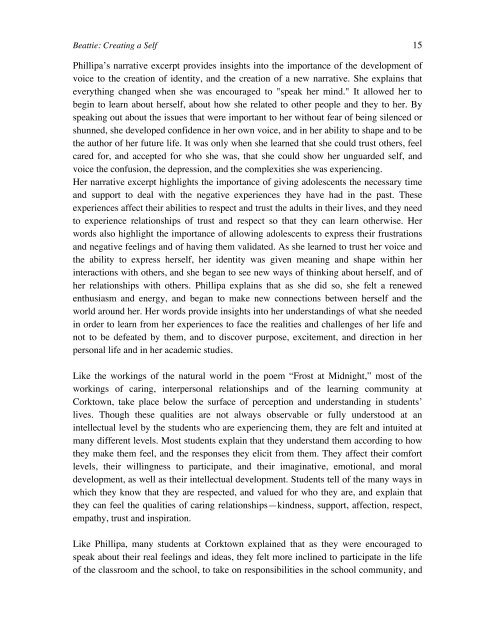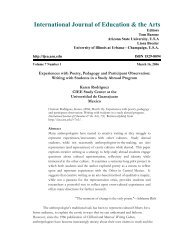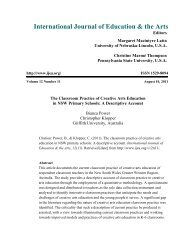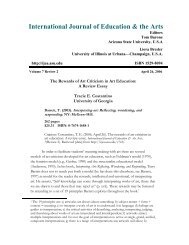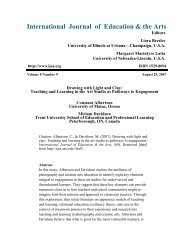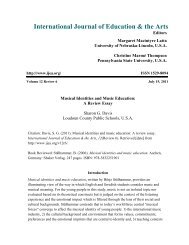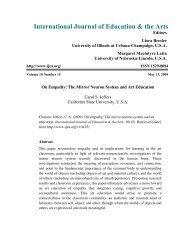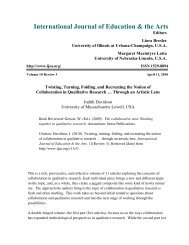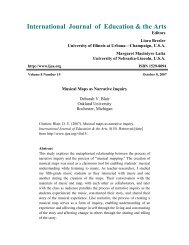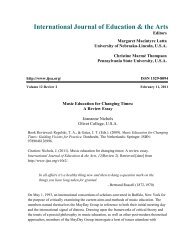Creating a self: A narrative and holistic perspective
Creating a self: A narrative and holistic perspective
Creating a self: A narrative and holistic perspective
Create successful ePaper yourself
Turn your PDF publications into a flip-book with our unique Google optimized e-Paper software.
Beattie: <strong>Creating</strong> a Self 15Phillipa’s <strong>narrative</strong> excerpt provides insights into the importance of the development ofvoice to the creation of identity, <strong>and</strong> the creation of a new <strong>narrative</strong>. She explains thateverything changed when she was encouraged to "speak her mind." It allowed her tobegin to learn about her<strong>self</strong>, about how she related to other people <strong>and</strong> they to her. Byspeaking out about the issues that were important to her without fear of being silenced orshunned, she developed confidence in her own voice, <strong>and</strong> in her ability to shape <strong>and</strong> to bethe author of her future life. It was only when she learned that she could trust others, feelcared for, <strong>and</strong> accepted for who she was, that she could show her unguarded <strong>self</strong>, <strong>and</strong>voice the confusion, the depression, <strong>and</strong> the complexities she was experiencing.Her <strong>narrative</strong> excerpt highlights the importance of giving adolescents the necessary time<strong>and</strong> support to deal with the negative experiences they have had in the past. Theseexperiences affect their abilities to respect <strong>and</strong> trust the adults in their lives, <strong>and</strong> they needto experience relationships of trust <strong>and</strong> respect so that they can learn otherwise. Herwords also highlight the importance of allowing adolescents to express their frustrations<strong>and</strong> negative feelings <strong>and</strong> of having them validated. As she learned to trust her voice <strong>and</strong>the ability to express her<strong>self</strong>, her identity was given meaning <strong>and</strong> shape within herinteractions with others, <strong>and</strong> she began to see new ways of thinking about her<strong>self</strong>, <strong>and</strong> ofher relationships with others. Phillipa explains that as she did so, she felt a renewedenthusiasm <strong>and</strong> energy, <strong>and</strong> began to make new connections between her<strong>self</strong> <strong>and</strong> theworld around her. Her words provide insights into her underst<strong>and</strong>ings of what she neededin order to learn from her experiences to face the realities <strong>and</strong> challenges of her life <strong>and</strong>not to be defeated by them, <strong>and</strong> to discover purpose, excitement, <strong>and</strong> direction in herpersonal life <strong>and</strong> in her academic studies.Like the workings of the natural world in the poem “Frost at Midnight,” most of theworkings of caring, interpersonal relationships <strong>and</strong> of the learning community atCorktown, take place below the surface of perception <strong>and</strong> underst<strong>and</strong>ing in students’lives. Though these qualities are not always observable or fully understood at anintellectual level by the students who are experiencing them, they are felt <strong>and</strong> intuited atmany different levels. Most students explain that they underst<strong>and</strong> them according to howthey make them feel, <strong>and</strong> the responses they elicit from them. They affect their comfortlevels, their willingness to participate, <strong>and</strong> their imaginative, emotional, <strong>and</strong> moraldevelopment, as well as their intellectual development. Students tell of the many ways inwhich they know that they are respected, <strong>and</strong> valued for who they are, <strong>and</strong> explain thatthey can feel the qualities of caring relationships—kindness, support, affection, respect,empathy, trust <strong>and</strong> inspiration.Like Phillipa, many students at Corktown explained that as they were encouraged tospeak about their real feelings <strong>and</strong> ideas, they felt more inclined to participate in the lifeof the classroom <strong>and</strong> the school, to take on responsibilities in the school community, <strong>and</strong>


